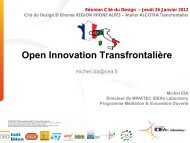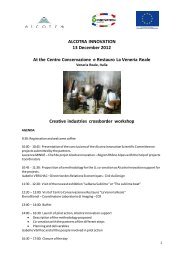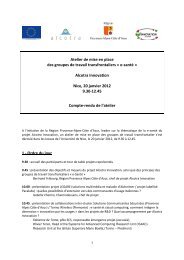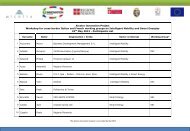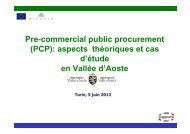Best practices Database for Living Labs - ALCOTRA - Innovation
Best practices Database for Living Labs - ALCOTRA - Innovation
Best practices Database for Living Labs - ALCOTRA - Innovation
Create successful ePaper yourself
Turn your PDF publications into a flip-book with our unique Google optimized e-Paper software.
• People (User) Integration in Design: the novelty of the <strong>Living</strong> <strong>Labs</strong> approach lies in the particular<br />
emphasis given to people’s involvement in the design process since the very early stages of the<br />
product/service development chain [11, 15]. This is something that goes beyond the traditional UCD<br />
principles, as they are typically anchored to the latest stages of testing, verification and validation;<br />
• Public Private Partnership: this is the most typical nature of European <strong>Living</strong> <strong>Labs</strong> – whenever they are<br />
established as such – and in that respect, it acquires a similar trait to the ‘support space’ of Innovative<br />
Milieux [21], or the territorial ‘Triple Helix’ required by the EC-funded Research Driven Clusters.<br />
As Almirall and Wareham [12] point out, <strong>Living</strong> <strong>Labs</strong> engage in a sort of intermediary role between<br />
individual users and the other local innovation stakeholders. In particular, they “organize users in needs<br />
finding exercises contributing to ideation, support them in acting as entrepreneurs, orchestrate the<br />
innovation process, organize user contribution in incremental innovation through localization exercises or<br />
promote societal involvement <strong>for</strong> a certain plat<strong>for</strong>m, product or service. There<strong>for</strong>e, playing a more<br />
encompassing and systemic role in the innovation process” that structures and provides governance to user<br />
participation in Open <strong>Innovation</strong>.<br />
While larger enterprises seem to have sufficient resources to avail themselves of a similar kind of<br />
infrastructure, a totally different story concerns SMEs – the natural market of election <strong>for</strong> the <strong>Living</strong> Lab’s<br />
‘services’. The diagram below depicts the distribution of a representative sample of “1 st and 2 nd wave”<br />
ENoLL members across a wide range of SME support services. Access to R&D communities, unsurprisingly,<br />
stands out as being the main service offered by nearly all <strong>Living</strong> <strong>Labs</strong>. Other important contributions<br />
emerging from the graph have to do with the role of <strong>Living</strong> <strong>Labs</strong> as technology plat<strong>for</strong>ms or data sources,<br />
possibly relevant to the purposes of product/service development and/or improvement thereof.<br />
Figure 3: Overview of <strong>Living</strong> <strong>Labs</strong> services - 2008 (from: [13])<br />
The project is co-funded by the ERDF<br />
Page 13 of 78



